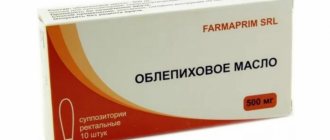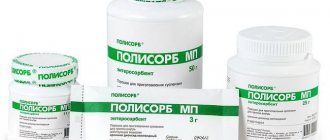Bladder inflammation requires immediate comprehensive treatment using both oral and vaginal medications. Uncomplicated acute cystitis in women can be treated even with local agents that have an antibacterial effect. These products include suppositories or vaginal suppositories. They can be aimed at eliminating any one of the symptoms of cystitis, but the most effective are suppositories with a combined property. Palin suppositories, also known as Urosept, are included in the list of drugs used in the treatment of cystitis.
The drug "Palin"
Compound
- One capsule of Palin contains 200 mg of pipemidic acid. Additional components: silicon dioxide, starch, magnesium stearate. Composition of the capsule shell: sunset yellow dye, titanium dioxide, gelatin. Composition of the capsule cap: quinoline yellow dye, titanium dioxide , sunset yellow dye, blue dye, diamond black dye, gelatin.
- One film-coated Palin tablet contains 400 mg of pipemidic acid.
- One Palin vaginal suppository contains 200 mg of pipemidic acid.
Features of treatment with fluoroquinolones
"Palin" is an antibiotic from the group of first generation quinolones. There are other names of the drug on sale with the same active substance in the composition:
- "Pimedin";
- "Urodipin";
- "Uropalin";
- "Pipegal" and others.
Therapy with Palin requires constant monitoring of hepatic and renal function and laboratory tests for the sensitivity of pathogens to the drug. Since the main pathogens of genitourinary infections often develop resistance to drugs that are quinolone derivatives, including Palina. Sometimes this takes only a few days after starting treatment.
Due to increasing resistance to the drug, it is classified as a secondary drug. It remains a drug for complicated cystitis. For uncomplicated bladder inflammation, it is recommended to avoid fluoroquinolone antibiotics whenever possible.
Pharmacodynamics and pharmacokinetics
Pharmacodynamics
Antibacterial drug, belongs to quinolones . Has a bactericidal effect. The medicine is active against gram-negative microorganisms: Enterobacter spp., Proteus vulgaris, Klebsiella pneumoniae, Escherichia coli, Pseudomonas aeruginosa, Neisseria spp.; and gram-positive microorganisms: Staphylococcus aureus.
The drug has no activity against anaerobic bacteria.
Pharmacokinetics
After taking 400 mg of the drug, the maximum concentration of pipemidic acid is recorded after 75-80 minutes. Bioavailability averages 30-60%. High concentrations of the drug are detected in urine, kidneys and prostate secretions. Passes through the hematoplacental barrier. Pipemidic acid is excreted in small amounts in breast milk.
Excreted in urine in its original form. The half-life is 2 hours.
In what cases is it necessary to take the drug?
"Palin" is used in the treatment of both the upper and lower urinary tract for acute and chronic infections.
The drug is used in the treatment of the following diseases:
- pyelonephritis (any form);
- cystitis;
- urethritis;
- prostatitis, etc.
For cystitis, a fluoroquinolone antibiotic is also used as an anti-relapse agent. As a prophylactic drug, an antibiotic is prescribed during instrumental examinations in the field of gynecology and urology.
The drug meets the following requirements necessary for the treatment of cystitis:
- active against the most common infectious agents (Escherichia coli, Klebsiella);
- creates high concentrations in urine;
- does not have a toxic effect on the kidneys;
- capable of causing the death of microorganisms;
- at a urine pH level of 6-9 it continues to be active.
At the first signs of cystitis, treatment with Palin can be prescribed empirically. After laboratory identification of the causative agent of infection, treatment with the drug continues or is replaced with another antibiotic.
Practitioners recommend treating cystitis with 3rd and 4th generation antibiotics, which are more effective and resistant to infectious agents. These include Furamag, Fosfomycin and Ceforal.
But cystitis in its pure form occurs only in 30% of patients; in the remaining 70% it is accompanied by other diseases of the urogenital type. In such a situation, “Palin” does not maintain a therapeutic effect, since pipemidic acid does not have an inhibitory effect on fungi of the genus Candida, chlamydia, mycoplasma and trichomonas.
Side effects
- Reactions from the hematopoietic system: in persons with a deficiency of the enzyme glucose-6-phosphate dehydrogenase, hemolytic anemia may appear ; Thrombocytopenia may occur in older people and people with changes in kidney function .
- Reactions from the nervous system: headache , tremor , visual disturbances, sleep disorders , agitation, depression, hallucinations , sensory disturbances, convulsions , less often convulsive seizures .
- Reactions from the digestive system: gastralgia , nausea, pseudomembranous colitis, diarrhea , vomiting .
- Allergic reactions: urticaria , Stevens-Johnson syndrome.
- Other reactions: superinfection, photosensitivity , possible development of resistance.
Instructions for use Palin (Method and dosage)
Palin suppositories, instructions for use advise women with genitourinary tract infections to take 1 vaginal suppository in the evening for one and a half weeks along with tablets or capsules.
Palin tablets and capsules instructions for use recommend taking 200 mg of the drug in the evening and morning before breakfast and dinner.
For staphylococcal lesions, the time between doses of the drug should not exceed 8 hours. The course of therapy lasts on average one and a half weeks. If necessary, it can be increased depending on the clinic and course of the disease.
For kidney damage, the course of therapy can reach 6 weeks, for inflammation of the prostate gland - 8 weeks. During the treatment period, the patient is advised to drink more.
Composition and effect
As the instructions for use inform, the main active ingredient of “Palina” is pipemidic acid. This is a medicine with an antibacterial effect.
Pipemidic acid is a synthetic drug that has an antimicrobial effect on the main pathogens of cystitis - Escherichia coli, Klebsiella, Proteus. Acid inhibits the growth and spread of bacteria, i.e. has a bacteriostatic effect, but also disrupts the DNA structure of Escherichia coli cells and other pathogenic microorganisms, which leads to their death (bactericidal effect).
The product is well absorbed into the blood and other body fluids and after 1-2 hours the highest concentration is reached in the urine, so it is effective in the treatment of bladder inflammation.
In addition, about 94% of the active substance is retained unchanged until excreted from the body. The rest, after metabolism, turns into weaker acids, but with the same spectrum of action.
The drug is excreted from the body by the kidneys (70%), the rest by the gastrointestinal tract.
Overdose
There are no reports of severe side effects or death following an overdose of Palin.
Symptoms: vomiting, nausea, dizziness , confusion, tremors , headache , convulsions.
Treatment: unknown antidote, gastric lavage, use of activated carbon . seizures occur, diazepam is recommended .
Adverse reactions of the body to the drug
Like all first-generation fluoroquinolones, Palin can lose the selectivity of its action and inhibit not only the cells of infectious agents, but also the cells of the human body itself, and at the same time cause various side effects.
"Palin" as a synthetic antibiotic is capable of causing reactions in the body from the digestive, central nervous, and hematopoietic systems:
- nausea, vomiting, diarrhea;
- decreased appetite;
- heartburn;
- stomach ache;
- headache;
- vertigo (dizziness);
- confusion in consciousness;
- tendency to depression;
- anemia;
- changes in cartilage tissue;
- tendon inflammation;
- visual and hearing impairment in rare cases and in case of overdose.
A common side effect is allergy, manifested by skin rash, itching and hives.
If the medicine is taken in doses greater than recommended, the overdose is manifested by typical signs of intoxication: nausea, vomiting, headache, and possibly confusion. In such a situation, you should seek the help of a doctor. If this opportunity is not quickly provided, the instructions for use recommend performing gastric lavage (when taking tablets and capsules), taking absorbent drugs and, in order to speed up the removal of toxins from the body, using diuretics (diuretics), preferably of herbal origin.
In case of overdose, you should immediately consult a doctor
Interaction
Pipemidic acid inhibits the metabolism of theophylline and caffeine .
The combined use of antacids and sucralfate suppresses the adsorption of pipemidic acid ; exposure to these drugs should be less than three hours.
Pipemidic acid activates the effects of rifampicin , cimetidine , warfarin and non-steroidal anti-inflammatory drugs .
When used together with aminoglycosides, a synergistic antibacterial effect was revealed.
Interaction with other drugs
Taking Palina can enhance the effect of some drugs, inhibit others and cause adverse reactions in the patient.
This antibiotic cannot be combined with nitrofuran derivatives (Furazolidone, Nifurantel, Furagin, Furadonin). Using Palin with other fluoroquinolones may increase adverse reactions and lead to seizures. Taking Palina tablets or capsules together with antacids reduces the effect of the latter, since antacids tend to coat the stomach walls and reduce absorption. A minimum 4-hour interval should be maintained between doses of these medications.
special instructions
Use the drug with caution in persons with a history of changes in cerebral circulation, convulsions , and in persons over 70 years of age.
Since photosensitivity , during treatment it is necessary to limit yourself from ultraviolet radiation.
This medicine should not be used in children. Pipemidic acid can accumulate in cartilage tissue.
When using the drug, it is recommended to refrain from driving.
Precautions when taking the product
It is prohibited to take "Palin" in the following cases:
- with impaired renal and liver function;
- during pregnancy and lactation;
- childhood (disturbs the formation of the skeleton);
- epilepsy;
- allergic reaction to the components of the drug.
The instructions for use inform you that while taking the medicine you should avoid exposure to direct sunlight and avoid visiting a solarium, as the active substances make the body's cells unstable to the adverse effects of ultraviolet radiation.
Pipemidic acid can cross the placenta and also enter breast milk; for this reason, Palin is not prescribed during pregnancy. If treatment with this particular drug is necessary, breastfeeding is interrupted.
In people aged (after 70 years) and suffering from kidney failure, taking antibiotics is carried out only under the supervision of a doctor, as it requires constant dose adjustment and observation.
Palina price, where to buy
The price of Palin tablets in Russia is 80-105 rubles; for comparison, capsules No. 20 cost 182-194 rubles. In Ukraine, the price of Palin in capsules is close to 114 hryvnia.
- Online pharmacies in UkraineUkraine
- Online pharmacies in KazakhstanKazakhstan
Pharmacy24
- Palin 200 mg N20 capsules Lek pharmaceutical company d.d., Slovenia
177 UAH.order
PaniPharmacy
- Palin capsule Palin capsules 200 mg No. 20 Slovenia, Lek
198 UAH order
show more







